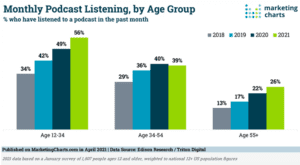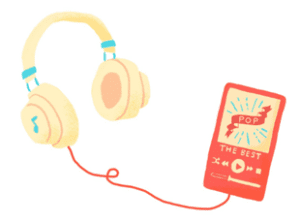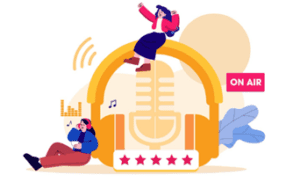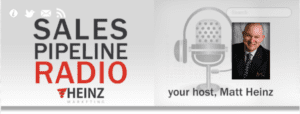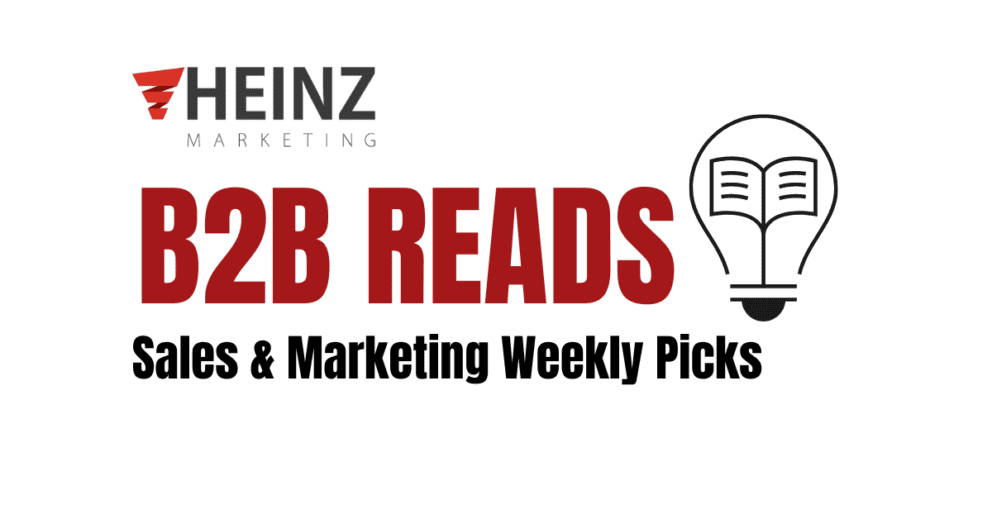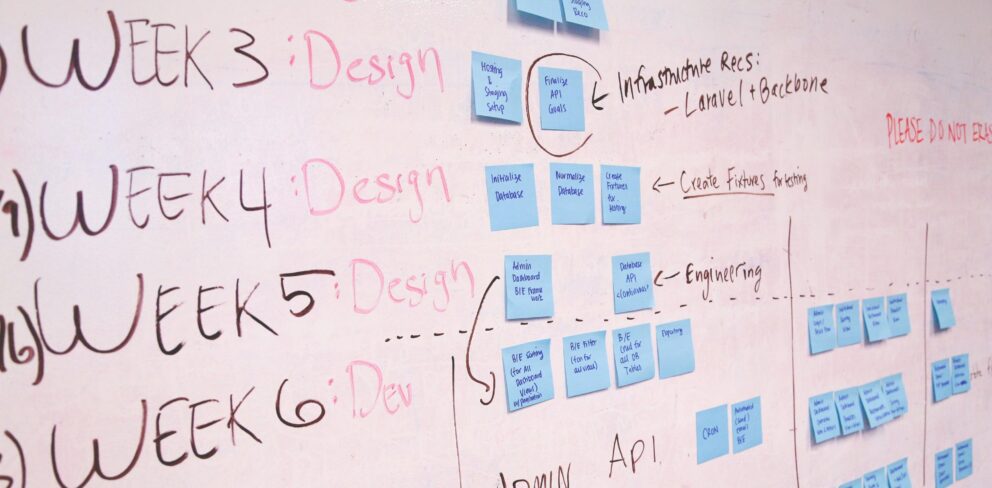How a Millennial Marketer’s Journey to Adopting Podcasts Can Help B2B Marketers Reach Their ICP

By Sarah Threet, Marketing Consultant at Heinz Marketing
Why I’m Trying to Become a Podcast Listener
While I have worked in marketing for the better part of a decade, I don’t have much experience with podcasts, professionally or personally. Listening to something in audio format (that isn’t music) can be difficult for me; I prefer visuals and subtitles (even though I’m a hearing person) and have a challenging time staying “tuned in” to what is being said either on the radio, in an audiobook, or in a podcast.
However, I am trying to practice more mindfulness, get back into creative hobbies, and significantly reduce my social media consumption. I’ve been using social media for two-thirds of my life, and after the pandemic hit, my media consumption sky-rocketed. While there are plenty of benefits to social media, and while it is currently a necessary channel for promoting your products/services, my little millennial brain craves more meaning in my life. I’m burnt out with the endless scroll, the doomsday news, the lack of empathy in discourse, and an algorithm that owns my time and attention. I need healthier forms of stimulation, to be able to create things with my hands again, and to consume more knowledge rather than hype.
So far, I have found that podcasts slow me down, help with my existential anxiety, are excellent for practicing more mindful listening, and allow me to multi-task to a certain degree (cooking, walking, playing with my cat, and making art). I cannot simultaneously scroll on my phone and actively listen to a podcast, so I have to choose the podcast!
I’m not the only one who chooses podcasts for similar reasons.
Why Other Consumers Listen to Podcasts
Most consumers listen to podcasts for entertainment and learning purposes, though out-of-home purposes of listening expand beyond these two popular reasons, given the platform’s advantages with control of content, mobility, and the ease of “escape”. The location of listening may change the purpose of listening, as folks are more engaged while listening at home or in the car than when they are out-and-about, when they might just need something to pass the time.
I resonated with some quotes from listeners in my age group who said that they liked listening to podcasts because they are “more passive” and allow for multi-tasking, that you have more control over what you listen to, unlike with radio, and that podcasts provide a “diverse range of news ideas and thoughts from vastly different people”, which allows us to both pull ourselves out of “echo chambers” as well as find hosts who are more like us.
Consumer reasons for listening to podcasts also vary by age: younger listeners tend to listen to podcasts for entertainment purposes and to pass time, as well as a means of change from just listening to music, whereas older listeners prefer to listen to podcasts to learn something new and stay up to date on current events.
What Podcasts I Listen to, How I Discovered Them, and Where I Listen to Them
I had no idea where to start with my Podcast Journey, so I asked my followers and friends for recommendations. Like most consumers, I value personal recommendations the most, and then usually use supplementary recommendations through public reviews or from influencers and thought leaders I respect.
I knew going into podcast-listening that I wanted to prioritize educational podcasts; learning is stimulating for me, and I guess I feel like I’m “wasting less of my time” when I’m learning new stuff. However, there are so many podcasts out there (over 2 million – a quadruple increase from 2018), and I’m awful at making decisions; the number of options are overwhelming, and to be honest, at first it made me freeze up from having too many choices. That’s why I think it’s so important to promote your podcasts through other channels, because the app/platform spaces are highly competitive. If an influencer I respect mentions a podcast or episode, I’ll go check it out – and frankly, having someone else choose for me is sometimes relieving.
I’m an Apple user for my mobile devices, so my most frequent platform is Podcasts, but I do also use Spotify for some missing content. For example, my partner purchased me an annual subscription to a podcast hosted by a thought leader he admires, as the two of us enjoy having deep philosophical questions and this provided a means of having topics to talk about. But the podcast subscription was only available through Spotify, rather than on Podcasts, so I must split up my platform use (minorly annoying).
Lastly, I prefer at-home listening where I can meal-prep, make art, or entertain my very needy cat. I personally find it difficult to actively listen to podcasts if I’m the one who is driving, but if I use public transportation or my partner is driving, I enjoy it. Beyond that, I may turn on a work-related podcast during work, or I may listen to something while waiting for an appointment somewhere.
Podcast Demographics: Who, Where, How?
Who:
Younger, educated, and affluent audiences tend to be the larger consumers of podcasts. Recent studies suggest that the average listener is 25-45, usually college-educated with an above-average household income, and leans slightly more male than female.
However, this data is new and biased and did not survey people of color. Podcast listenership is becoming increasingly diverse, with more people of all ages, genders, ethnicities, and backgrounds tuning in. This can be attributed to the growing popularity of podcasts as a form of entertainment and education, with diverse topics and genres, as well as the increasing accessibility of podcasts through smartphones, tablets, and other mobile devices.
Who is your ICP, what pain points might they resolve listening to your podcast, and how will you get them to listen to your podcast given what you know about what channels they may frequent the most?
Where:
Weekly podcast listeners tend to listen at home more than in their car, but car-listening is slowly increasing (~60% vs 20%). Listeners over 35 listen from home more than younger listeners, and younger listeners listen more mobile. Following these listening locations, 18% of listeners tune in while out-and-about (non-transportation or exercise related), 16% while exercising, and 16% while at work.
The average length of podcasts is typically between 20-40 minutes and that is partly influenced by the time taken on the average commute, since in-car listening is popular. In the News industry, certain podcasts may prioritize posting their news before the morning rush hour, and news like Post Reports from the Washington Post are released in time for the evening commute (Digital News Report).
Where might your ICP be hanging out? Where and when might be most convenient for them to listen to a podcast, and should that influence the average length of your podcast episodes?
How:
The most popular podcast platforms are Spotify, Podcasts (Apple), and Google Podcasts – 25%, 20%, and 16% respectively.
Spotify has become one of the most popular platforms for podcast listening for several reasons:
- Integration with Music Streaming: Spotify already had a large user base of music streamers, and the platform began incorporating podcasts into its offering, allowing users to access both types of content in one place (unlike Apple Music and Podcasts – a frustration I do have!).
- Personalization and Discovery: Spotify offers personalized recommendations for podcasts based on a user’s listening habits, as well as curated playlists and other discovery tools to help users find the latest content.
- Exclusive content: Spotify has invested heavily in exclusive podcast content, including original programming, and exclusive distribution deals with popular podcasters. This has helped attract new users to the platform and keep them engaged.
- User Experience: Spotify has a user-friendly interface that is easy to navigate, making it simple for listeners to find and play podcasts.
- Partnerships: Spotify has formed partnerships with a variety of podcast networks and producers, which has helped expand the range of content available on the platform.
Despite the industry namesake originating with Apple, Spotify jumped at the podcast opportunity with more fervor, investing money and making partnerships to make podcast listening more accessible to their large user base. While Apple may include personalization as well, I have always personally found that Spotify gets much more niche with their recommendations.
Lastly, listeners tend to be invested in certain hosts, and if those hosts are guests on other podcasts, they are likely to listen, or if that podcast host recommends another podcast, listeners are likely to adopt.
Podcast Demographics for B2B Clients
What about your target account – what podcasts might they be listening to? Overall, the most popular types of podcast content for business professionals are those that offer practical tips, insights, and advice that can help them improve their skills and advance their careers. Here are some popular topics your client might be listening to:
- Marketing and Advertising: Popular among marketers and business professionals, these podcasts offer insights into the latest marketing trends, strategies, and best practices.
- Entrepreneurship and Business: These podcasts are popular among business professionals who want to stay up to date on the latest business news and trends. They often feature interviews with successful entrepreneurs and business leaders.
- Productivity and Time Management: Podcasts that offer tips and advice on productivity and time management are popular among business professionals who are looking for ways to be more efficient and effective in their work.
- Sales: Popular among business professionals who are involved in sales or business development, these podcasts offer insights into the latest sales techniques, strategies, and best practices.
- Leadership and Management: Podcasts that cover leadership and management topics are popular among business professionals who are looking to improve their leadership skills and manage their teams more effectively.
- Industry-Specific Content: Many business professionals listen to podcasts that cover industry-specific content relevant to their work. For example, those working in the tech industry may listen to podcasts that cover the latest developments in technology or startups.
In what ways is your company a thought leader and what are some new insights you may be able to appropriately provide through a medium like podcast episodes? What can you say that provides value to your ICP?
Accessibility Hurdles
As a neurodivergent person, I knew getting into listening to podcasts wasn’t going to be easy for me, but that’s part of the reason why I am doing it. That said, I’ve noticed a few things that can hinder adoption, and I always care about addressing inclusion.
One example comes from the podcast my partner subscribed me to; the host provides some shorter episodes that are compilations of interviews that he has had on a particular subject, narrated by another person providing context and how all the interviews align on that subject. Typically, this host’s podcasts can be up to 2-3 hours and are dense subjects. I think it’s great that he includes some of these shorter, more easily digestible compilation podcasts; they’re free and they provided me with enough information to tell my partner that I’d be willing to commit to a subscription.
Of course, that host’s target audience is not the typical podcast user who wants something lighter, shorter, and easier to digest. You’ll want to consider these options for your own ICP or additional personas.
What options can you provide that are easier to listen to and illustrate your podcast well enough to encourage subscription? If you’d prefer to have your content be free with sponsored advertisement, what sponsors might you consider advertising, and is the ad relevant to the episode and bringing value to your ICP, or will it just be a nuisance? How can you make the advertisement easier to swallow through choice of placement in the episode and through choice of who says it?
Certainly, use your podcast to promote your own services, products, or other valuable resources that you might have on your website or blog.
Lastly, regarding accessibility, equity, and inclusion, audio formats are not very friendly for folks who are hard of hearing. There are methods to add closed captioning to podcasts, but they are not user friendly and the way to include them depends on the application/platform. Still, I encourage having detailed, SEO appropriate show notes (episode descriptions) and including a PDF to an official transcript that may be downloaded. Another helpful piece is to keep the formatting of your episodes consistent and utilize chapter markers (especially if you provide longer episodes with meatier content).
Hopefully, these insights will give you more information on whether podcasts are appropriate for your ICP and how to target them effectively and mindfully.
By the way, our founder, Matt Heinz has an award winning podcast, Sales Pipeline Radio. He goes live Thursdays on LinkedIn and YouTube. Transcripts with audio and video links are found right here on the blog on most Mondays. We feature the brightest minds in B2B sales and marketing, sharing secrets to driving greater volume, velocity and conversion of sales pipelines in any industry. We cover the entire pipeline– demand generation, lead management, sales effectiveness, technology and more– all focused on helping you find, manage and win more business.

